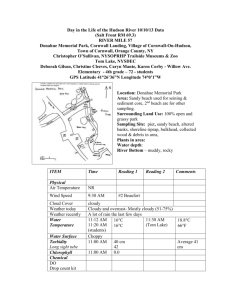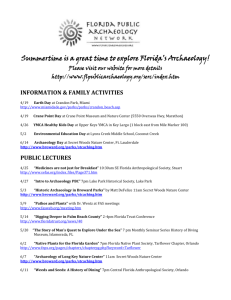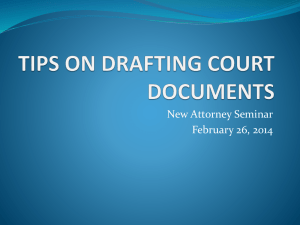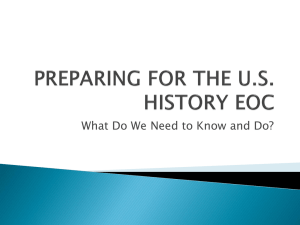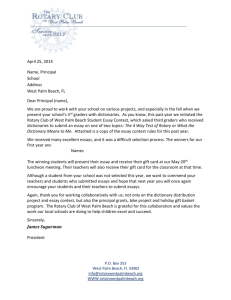WORD - Florida Department of Environmental Protection
advertisement
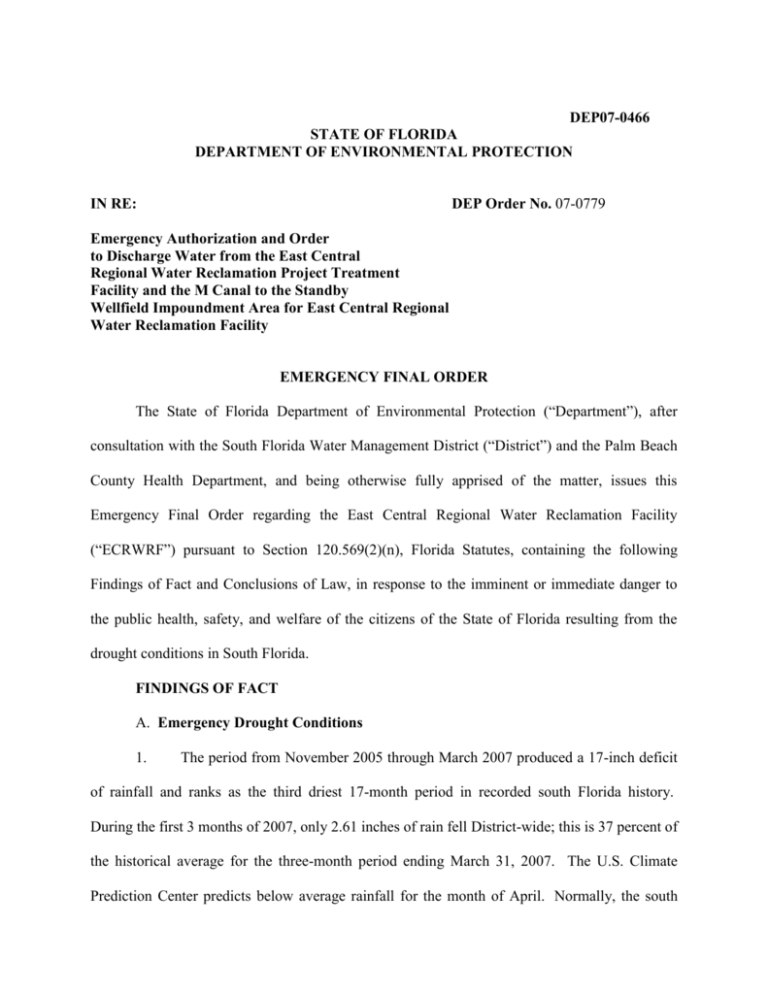
DEP07-0466 STATE OF FLORIDA DEPARTMENT OF ENVIRONMENTAL PROTECTION IN RE: DEP Order No. 07-0779 Emergency Authorization and Order to Discharge Water from the East Central Regional Water Reclamation Project Treatment Facility and the M Canal to the Standby Wellfield Impoundment Area for East Central Regional Water Reclamation Facility EMERGENCY FINAL ORDER The State of Florida Department of Environmental Protection (“Department”), after consultation with the South Florida Water Management District (“District”) and the Palm Beach County Health Department, and being otherwise fully apprised of the matter, issues this Emergency Final Order regarding the East Central Regional Water Reclamation Facility (“ECRWRF”) pursuant to Section 120.569(2)(n), Florida Statutes, containing the following Findings of Fact and Conclusions of Law, in response to the imminent or immediate danger to the public health, safety, and welfare of the citizens of the State of Florida resulting from the drought conditions in South Florida. FINDINGS OF FACT A. Emergency Drought Conditions 1. The period from November 2005 through March 2007 produced a 17-inch deficit of rainfall and ranks as the third driest 17-month period in recorded south Florida history. During the first 3 months of 2007, only 2.61 inches of rain fell District-wide; this is 37 percent of the historical average for the three-month period ending March 31, 2007. The U.S. Climate Prediction Center predicts below average rainfall for the month of April. Normally, the south Florida rainy season does not begin until late May; thus, prospects are poor for sustained, significant rainfall for the next month or two. 2. The Water Conservation Areas are the primary water supply source to Water Use Basins in the Lower East Coast during the dry season. They are relied upon to manage groundwater levels east of the WCAs, recharge wellfields, supply water users, and prevent saltwater intrusion into the surficial aquifer system in the affected area. Water availability in the WCAs is well below average for this time of year. 3. Lake Okeechobee is the back-up supply for dry season surface water recharge to the Lower East Coast Region and the WCAs. However, the Lake’s stage as of May 10, 2007 was 9.37 feet NGVD. The water level of Lake Okeechobee is approximately 4.5 feet below its historical average (1992 – 2000) for this time of year, and about 4 feet lower than it was in 2005 and 2006. Therefore, the potential for delivering water from Lake Okeechobee to the coast is becoming physically limiting and could become impossible. 4. Temporary forward pumps have been installed at structures conveying water south of Lake Okeechobee, since gravity flows cannot occur at current lake stages. These pumps have significantly limited capacities for delivering water to the WCAs and the coast, and will primarily be relied upon to provide water to the agricultural users within the Everglades Agricultural Area (EAA) at substantially reduced levels. Due to the very limited pump capacities and the large amount of conveyance losses that occur as the water is transported many miles from the Lake to the coast, it is nearly physically impossible to use the temporary forward pumps to move water supplies to the coast and also attain an appreciable effect. In order to make even the most minimal deliveries to the coast, water supplies to the agricultural interests have to be terminated for many days, as coastal deliveries are attempted. 5. The Surficial Aquifer System in the Lower East Coast basins provides drinking water supply to the millions of people residing in the Lower East Coast Region. The public water supply utility wellfields located near the saltwater interface are particularly vulnerable to intrusion. If the fresh groundwater levels decline, a significant potential for saltwater intrusion into the Lower East Coast Region’s surficial, fresh water aquifers exists. If a public water supply wellfield becomes contaminated with saltwater, it may no longer be used to provide drinking water without desalination treatment, thereby, threatening public health, safety and welfare. Moreover, once an aquifer experiences saltwater intrusion, it can take many years, if ever, for the saltwater front to be pushed seaward. 6. In rural areas of the affected Basins, surface water in canals provide water supply for fire fighting purposes. Currently, drought conditions have elevated the potential for fires. Lack of water in these canals could represent an increased threat to public health, safety, and welfare. B. Declaration of Water Shortage Emergencies 7. Based on declining water availability and substantial water user demands, on March 15, 2007 (Order No. 2007-034-DAO-WS), the Governing Board of the District imposed mandatory water shortage restrictions on the Lower East Coast Region, and increased those restrictions on April 12, 2007 (Order No. 2007-056-DAO-WS) and April 23, 2007 (Order No. 2007-100-DAO-WS), as a result of drought conditions that substantially intensified. C. Emergency Conditions in the L-8 Basin 8. Under normal conditions, the L-8 Basin generates considerable runoff during both the wet season and the first half of the dry season with annual runoff volume on the order of 70,000 acre-feet per year. The runoff from this basin usually extends for months after the wet season due to its large area and the percentage of natural areas. During the wet season, most of this water is discharged to tide via the C-51 Canal. During the dry season, the City of West Palm Beach pumps water from the L-8 Basin to supply water to the Grassy Waters Preserve and the City of West Palm Beach Water Treatment Plant (Figure 1/Exhibit A). 9. When local runoff is not available, Lake Okeechobee water is usually brought into the L-8 Basin by gravity, from the west, through the C10A and S-76 structure in quantities to maintain canal levels while supplying water to the City of West Palm Beach (for maintenance of water levels in Grass Waters Preserve and public water supply). Due to current water levels in Lake Okeechobee, this route is no longer available with the existing infrastructure. However, there is a continuing need for water in the L-8 and M canals and a need to judiciously manage available water to prolong supplies and minimize drought impacts. Emergency Order OGC No. 07-0678 allows discharges from the L-8 Impoundment Project to the L-8 Canal which is in turn conveyed to the M Canal. 10. The East Central Regional Water Reclamation Facility (ECRWRF) is located in central Palm Beach County. The ECRWRF is funded and governed by a board comprised of the representatives of the entities served by this facility, namely: the City of West Palm Beach, the City of Lake Worth, the City of Riviera Beach, the Town of Palm Beach, and Palm Beach County. The ECRWRF is currently permitted to process 55 million gallons of wastewater per day (MGD). This facility provides secondary treatment and uses deep well injection for effluent disposal and operates under the leadership of the City of West Palm Beach, Director of Public Utilities. 11. The City of West Palm Beach owns and operates the Wetlands Based Water Reclamation Project (Water Reclamation Project) at the ECRWRF. The water reclamation project is an innovative program that enables the City to reuse treated reclaimed water to enhance wetlands and recharge the surficial aquifer that feeds the City water supply. The Water Reclamation Project diverts a portion of the secondary effluent, provides an additional high-level of treatment including filtration and ultra violet (UV) disinfection, and is capable of providing up to 10 million gallons per day (MGD) of reclaimed water from the ECRWRF. The system is designed to achieve Advanced Wastewater Treatment (AWT) criteria for nutrients (nitrogen and phosphorous) and removal of bacteria and other pathogens. 12. The Water Reclamation Project is currently operated pursuant to a National Pollutant Discharge Elimination System (NPDES) Domestic Wastewater Facility Permit (Permit Number FL0041360) issued by the Department. This permit authorizes the discharge of 6.0 MGD annual average daily flow (10.0 MGD maximum daily flow) of highly treated reclaimed water, which has received Advanced Wastewater Treatment and UV disinfection, to an Isolated Receiving Wetland Reuse Site (Figure 1/ Exhibit A). The water from the wetland is then pumped to a standby wellfield and is used to supplement the City of West Palm Beach potable water supply in Clear Lake and Lake Mangonia via the M canal. 13. In the currently permitted discharge scenario, significant amounts of water are lost to evapotranspiration and seepage in the receiving wetlands (with very minimal flow reaching the standby wellfield/M-Canal). In consideration of the ongoing drought conditions, minimizing these losses and sending this additional water directly to the standby wellfield impoundment area to recharge the Surficial Aquifer and pump from the wells to the M Canal for intake, treatment, and distribution by the West Palm Beach Water Treatment Plant could provide appreciable drought-related benefits. Losses to evapotranspiration and groundwater can be minimized by discharging the highly treated reclaimed water from the Water Reclamation Project treatment facility, bypassing the wetlands, and sending it directly to the standby wellfield. 14. At this time, certain components of the Water Reclamation Project treatment facility known as the “Actiflow system” are not yet operating at full capacity during the startup of the treatment facility. These components normally provide additional removal of phosphorous to very low levels (better than AWT criteria), however this level of phosphorous removal is not critical if the reclaimed water is not discharging through the wetland. During this severe drought condition, in order to maximize the volume of water made available from the Water Reclamation Project, the City is authorized to deliver highly treated reclaimed water to the wellfield without treatment by the Actiflow system. All other treatment components of the AWT and high level disinfection system must be operating satisfactorily in accordance with the current approved operating protocols. This reclaimed water will not receive the additional phosphorous reduction provided by the Actiflow system and will not be routed through the wetlands as described in the permit. Upon the termination of this Emergency Order the ECRWRF will return to operating under the standards and conditions of NPDES Permit Number FL0041360. 15. To further minimize the evaporation, a temporary pump, authorized by the South Florida Water Management District, will pump surface water from the M Canal to an open trench sump adjacent to an existing Surface Water Pump Station #7 which discharges to the standby wellfield impoundment area. Simultaneously, Public Access Reclaimed Water (from the City of West Palm Beach's ECRWRF Water Reclamation Project Facility) will commingle with a portion of the surface water supplied by Surface Water Pump Station #7. This will be done by installing approximately forty feet of 36" diameter pipe to connect downstream from the Surface Water Pump Station #7 to an existing 36" diameter pipe. The existing 36" diameter pipe will convey the Public Access Reclaimed Water from the advanced wastewater treatment facility to the standby wellfield impoundment area. The commingling of the M Canal and the reclaimed water will occur within the 36" diameter pipeline located approximately one mile from a distribution header at the east side of the standby wellfield impoundment area. The commingled water will indirectly supplement the standby wellfield impoundment area. The berm around the wellfield has a minimum 3-foot freeboard. This water will recharge the groundwater and be discharged from the wells to the portion of the M canal, east of Florida’s turnpike and flow to it’s terminus at Lake Mangonia and Clear Lake. 16. The water can be withdrawn by the West Palm Beach Water Treatment Plant from Clear Lake for full treatment and distribution. Treated water can be used to supply West Palm Beach users and can also be provided to Lake Worth Utilities via an existing interconnect, which will reduce Lake Worth’s withdrawals from the surficial aquifer in an area that has a significant potential for salt water intrusion. Potential beneficial uses of this water include additional potable water for users in West Palm Beach and Lake Worth, reduced groundwater supply demands, and subsequently improved ability to prevent saltwater intrusion in coastal water supply wellfields. CONCLUSIONS OF LAW 17. Under Section 120.569(2)(n), F.S. the Secretary of the Department is authorized to issue this Emergency Final Order. 18. Section 373.026, F.S., authorizes the Department to exercise any power granted to a Water Management District. 19. Sections 120.569(2)(n) and 373.119(2) F.S., give the Department the authority, in the event of an emergency requiring immediate action to protect the public health, safety, or welfare, to issue an order reciting the existence of such an emergency and requiring that such action be taken as deemed necessary. 20. Due to water shortage conditions in the District, an emergency exists meriting the entry of an emergency order and authorization to discharge water from the ECRWRF Water Reclamation Project treatment facility, commingle it with water conveyed via the M Canal and directly send it to the standby wellfield impoundment area to supplemental regional water supplies. THEREFORE, IT IS ORDERED: A. The City of West Palm Beach is authorized to discharge up to 10 MGD of reclaimed water, which has been treated for nitrogen removal, filtered and subjected to UV disinfection, from the East Central Regional Water Reclamation Project treatment facility, directly to the standby wellfield impoundment area (Figures 2 and 3/Composite Exhibit C.). The highly treated reuse water from the East Central Regional Water Reclamation Facility may be commingled with the water from the M Canal, via a 36” diameter pipe, directly to the standby wellfield impoundment area. B. During the effective period of this Emergency Final Order, the City shall monitor water quality in discharges in accordance with the existing NPDES permit and in accordance with attached Exhibit D and shall provide reports to the Department on a weekly basis. C. This Emergency Final Order shall become effective immediately upon execution, and shall expire 90 days after issuance, unless otherwise extended or modified. D. This Order provides relief from the specific regulatory requirements addressed herein for the duration of the Order, and does not provide relief from the requirements of other federal, state, or local entities. NOTICE OF RIGHTS Pursuant to Section 120.569(2)(n) of the Florida Statutes, any party adversely affected by this Order has the right to seek an injunction of this Order in circuit court or judicial review of it under Section 120.68 of the Florida Statutes. Judicial review must be sought by filing a notice of appeal under Rule 9.110 of the Florida Rules of Appellate Procedure, with the Clerk of the Department in the Office of General Counsel, Mail Station 35, 3900 Commonwealth Boulevard, Tallahassee, Florida 32399-3000, and by filing a copy of the notice of appeal accompanied by the applicable filing fees with the appropriate district court of appeal. The notice of appeal must be filed within thirty days after this Order is filed with the Clerk of the Department. DONE AND SO ORDERED on this ____ day of May, 2007, at Tallahassee, Florida. FLORIDA DEPARTMENT OF ENVIRONMENTAL PROTECTION MICHAEL W. SOLE, Secretary 3900 Commonwealth Boulevard Tallahassee, Florida 32399-3000 FILED on this date, pursuant to §120.52, Florida Statutes, with the designated Department Clerk, receipt of which is hereby acknowledged. CLERK DATE : PLEASE SEE PDF VERSION FOR EXHIBITS.
